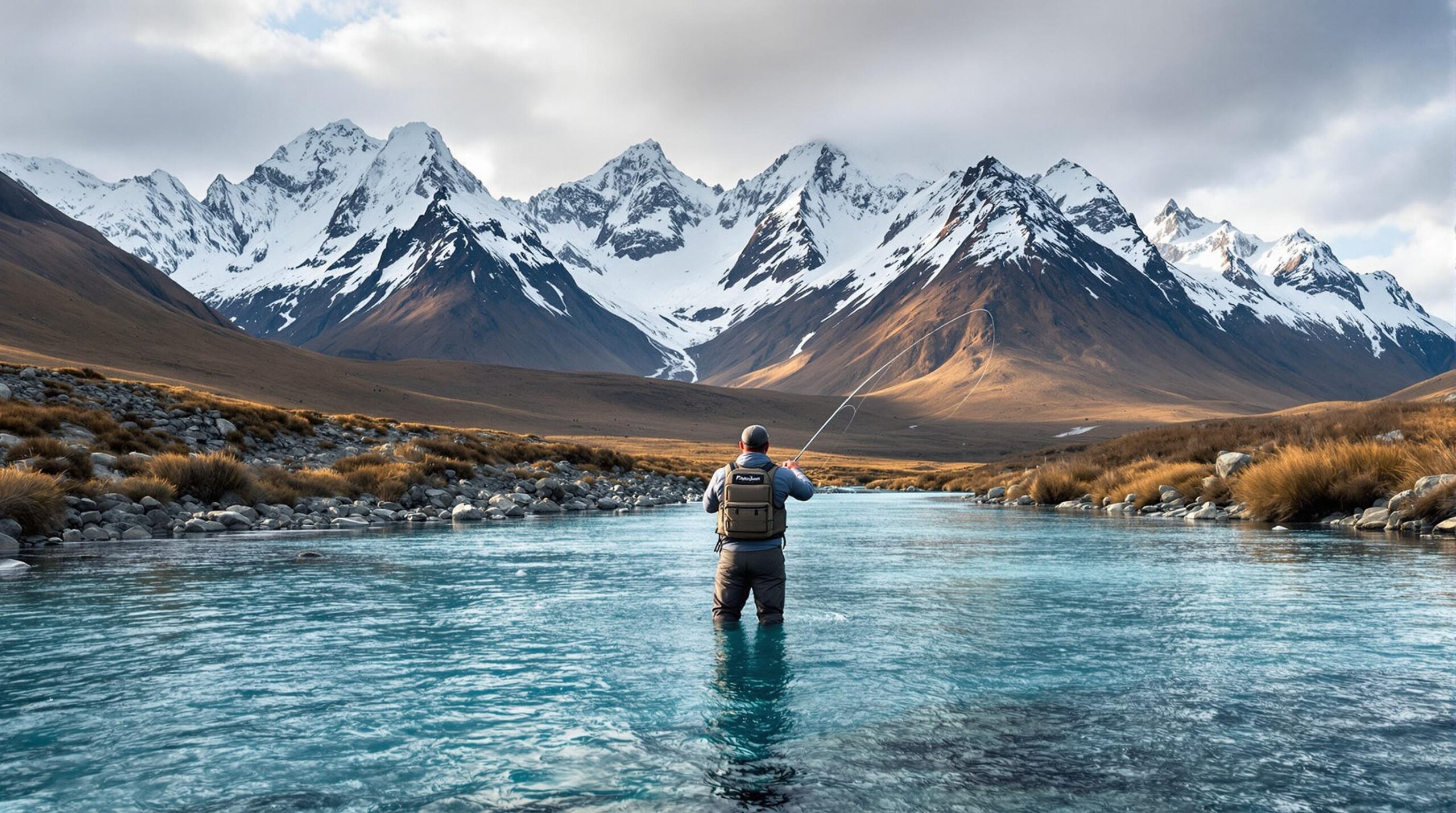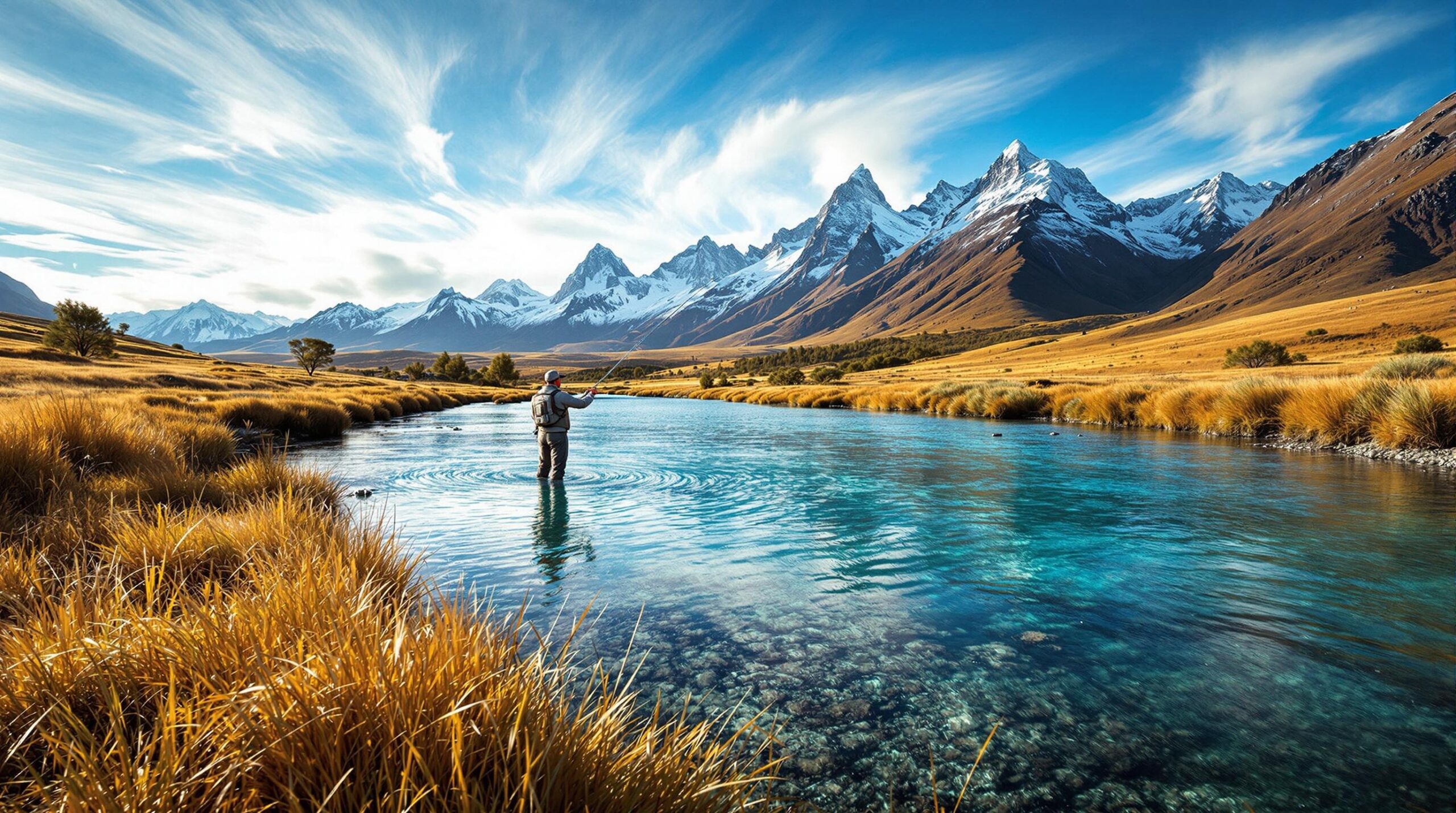According to the Fly Fisherman magazine’s global destination survey, Patagonia consistently ranks among the world’s top fly fishing destinations, with its pristine waters hosting some of the largest wild trout populations on Earth. The region’s unique geography, spanning both Argentina and Chile, offers anglers access to legendary rivers like the Rio Grande and Chimehuin, where brown trout exceeding 30 inches are caught regularly during peak seasons.
Key Takeaways
- Peak season runs from November through April, with December to March offering optimal conditions for targeting large brown and rainbow trout
- Essential preparation includes securing permits, booking accommodations 6-12 months in advance, and packing appropriate gear for variable weather conditions
- Prime rivers include Rio Grande for sea-run browns, Rio Chimehuin for trophy rainbows, and Rio Malleo for consistent dry fly action
- Travel logistics require flights to Buenos Aires or Santiago, followed by domestic connections to regional airports like Bariloche or Rio Gallegos
- Budget considerations range from $200-500 per day for guided fishing, with total trip costs varying significantly based on lodge selection and duration
Understanding Patagonia’s Premier Fly Fishing Waters
Patagonia’s reputation as a world-class fly fishing destination stems from its unique position at the southern tip of South America. The region spans both Argentina and Chile, creating diverse fishing opportunities across different ecosystems.
The area’s geography proves crucial to its fishing excellence. Patagonia’s rivers originate from glacial melt and pristine mountain watersheds, maintaining consistently cold temperatures throughout the fishing season. This environment supports healthy populations of both native and introduced trout species.
Most anglers focus on the Argentine side of Patagonia, where access to prime fishing areas proves more straightforward. The region’s comprehensive fishing opportunities include everything from technical dry fly fishing to streamer fishing for trophy-sized browns.
Premier Rivers for Trophy Trout
Rio Grande – The Sea-Run Brown Trout Capital
Rio Grande stands out as perhaps the most famous river in Patagonia’s collection of premier fishing waters. Located in Tierra del Fuego, this river hosts the world’s largest population of sea-run brown trout.
The river’s sea-run browns average 5-8 pounds, with fish exceeding 20 pounds caught annually. These fish migrate from the Atlantic Ocean into the river system, bringing exceptional strength and fighting ability that distinguishes them from their freshwater counterparts.
Peak fishing occurs from January through March when the largest sea-run browns enter the river. Access requires permits and guided fishing, as the river flows through private estancias with limited daily quotas.
Rio Chimehuin – Rainbow Trout Paradise
The Chimehuin River system offers some of Argentina’s most consistent rainbow trout fishing. Located in Neuquen Province, this river produces rainbow trout averaging 18-22 inches, with specimens exceeding 30 inches documented regularly.
The river’s structure includes long pools, technical riffles, and deep runs that hold fish throughout the season. Dry fly fishing excels during summer months, while streamers produce results during cooler periods.
Access to the Chimehuin is relatively straightforward, with multiple access points near Junin de los Andes. This accessibility makes it an excellent choice for anglers exploring Argentina’s premier fishing destinations.
Rio Malleo – Technical Dry Fly Fishing
Rio Malleo provides technical dry fly fishing opportunities in a stunning mountain setting. The river’s clear waters and selective trout demand precise presentations and careful approach techniques.
Brown trout dominate the Malleo system, with fish averaging 14-18 inches. The river’s technical nature makes it ideal for experienced anglers seeking challenging fishing scenarios.
The Malleo flows through Lanin National Park, providing dramatic scenery alongside excellent fishing. Permits are required for fishing within park boundaries, and camping is available at designated areas.
Seasonal Patterns for Maximum Success
Early Season (November-December)
Early season fishing in Patagonia begins as spring transitions to summer. Water temperatures remain cool, and insect activity builds toward peak levels.
November fishing can be challenging due to variable weather and lower water temperatures. However, fewer anglers mean less pressure on prime fishing spots.
December marks the beginning of consistent fishing, with improving weather conditions and increasing insect hatches. Streamers remain effective during this period, while dry fly opportunities increase as the month progresses.
Peak Season (January-March)
Peak season represents the height of Patagonia’s fishing opportunities. Water temperatures reach optimal levels, and terrestrial insects create consistent dry fly action.
January offers the best combination of weather and fishing conditions. Terrestrial patterns like hoppers and ants become increasingly important as summer progresses.
February and March continue to provide excellent fishing, with larger browns becoming more active as they prepare for spawning season. These months often produce the largest fish of the season.
Late Season (April)
April marks the end of the fishing season in most areas, as temperatures begin dropping and fish enter pre-spawning modes. However, this period can produce exceptional fishing for those willing to brave cooler conditions.
Streamer fishing becomes increasingly effective as brown trout grow more aggressive. The season’s largest fish are often caught during this period.
Weather becomes more unpredictable in April, requiring flexibility in fishing plans and appropriate cold-weather gear.
Essential Travel Planning
Getting There
International travel to Patagonia typically requires connections through Buenos Aires (Argentina) or Santiago (Chile). From these major hubs, domestic flights reach regional airports serving prime fishing areas.
Bariloche serves as the primary gateway to northern Patagonia’s fishing destinations. The airport offers rental car services and connections to various lodges and fishing areas.
Rio Gallegos provides access to southern Patagonia and Tierra del Fuego. This airport proves essential for anglers targeting Rio Grande’s sea-run brown trout.
Accommodation Options
Patagonia’s premier fishing destinations offer accommodation ranging from luxury lodges to basic camping facilities. Lodge selection significantly impacts both cost and fishing access.
High-end lodges provide all-inclusive packages with guided fishing, meals, and transportation. These facilities typically cost $500-800 per person per day but offer comprehensive services and prime fishing access.
Mid-range options include estancia accommodations and smaller lodges, offering guided fishing at $200-400 per day. These facilities provide excellent value while maintaining good fishing access.
Budget-conscious anglers can find camping opportunities and basic accommodations, though access to prime fishing areas may require additional planning and transportation.
Many anglers choose to stay at specialized fishing lodges that cater specifically to fly fishing enthusiasts and provide expert local knowledge.
Equipment and Preparation
Rod and Reel Specifications
Patagonia’s diverse fishing conditions require versatile equipment setups. Most anglers find success with 9-foot rods in 5-7 weight configurations.
A 6-weight rod provides the best all-around performance for Patagonia’s conditions. This weight handles the region’s large trout while maintaining sensitivity for technical presentations.
Reel selection should prioritize drag systems capable of handling long runs from large trout. Quality drag becomes essential when fighting sea-run browns or trophy rainbows.
Fly Selection
Successful fly selection in Patagonia requires patterns that match local food sources. The following categories represent essential fly types:
Dry flies should include terrestrial patterns like hoppers, ants, and beetles. These patterns remain effective throughout the summer season and appeal to the region’s opportunistic trout.
Streamers play a crucial role in Patagonia’s fishing success. Woolly buggers, zonkers, and baitfish patterns in various sizes and colors produce consistent results.
Nymphs become important during periods of reduced surface activity. Weighted patterns that reach deeper pools and runs often produce fish when dry flies fail.
Clothing and Weather Gear
Patagonia’s weather can change rapidly, requiring layered clothing systems and waterproof gear. Wind remains a constant factor that influences both fishing success and comfort levels.
Base layers should include moisture-wicking materials that maintain warmth when wet. Merino wool provides excellent temperature regulation throughout varying conditions.
Outer layers must provide wind and water protection while allowing freedom of movement for casting. Quality rain gear becomes essential equipment rather than optional backup.
Advanced Techniques for Success
Reading Patagonian Waters
Patagonia’s rivers present unique characteristics that require specific reading techniques. The region’s glacial-fed waters maintain exceptional clarity, allowing anglers to spot fish at considerable distances.
Current reading becomes crucial in Patagonia’s varied river systems. Understanding how glacial input affects water temperature and flow helps locate active fish throughout the day.
Structure identification helps anglers locate holding water in unfamiliar systems. Patagonian rivers often feature deep pools, undercut banks, and boulder gardens that concentrate fish populations.
Presentation Strategies
Wind management represents one of the most critical skills for success in Patagonia’s fishing waters. The region’s constant wind requires casting adjustments and fly selection modifications.
Approach techniques must account for clear water and wary fish. Patagonia’s trout often require long leaders and careful positioning to avoid spooking.
Timing presentations with natural feeding patterns increases success rates. Understanding when terrestrial insects become active helps anglers choose optimal fishing periods.
Fighting Large Fish
Patagonia’s trophy trout require specialized fighting techniques for successful landing. The region’s large fish possess exceptional strength and stamina that can test equipment and technique.
Pressure application must balance fish control with equipment protection. Patagonia’s large trout can easily break light tippets or damage reels with insufficient drag systems.
Landing techniques become crucial when dealing with large fish in challenging conditions. Having appropriate landing nets and release tools ensures successful fish handling.
Conservation and Ethics
Catch and Release Practices
Patagonia’s status among premier fishing destinations depends on maintaining healthy fish populations through responsible angling practices. Proper catch and release techniques ensure these fisheries remain productive for future generations.
Barbless hooks reduce injury to fish and speed releases. Most Patagonian fishing operations require or strongly recommend barbless hook policies.
Handling techniques should minimize stress and physical damage to caught fish. Using wet hands, supporting fish weight properly, and reducing air exposure improve survival rates.
Environmental Awareness
Patagonia’s pristine environment requires careful stewardship from visiting anglers. Understanding local regulations and environmental concerns helps preserve these unique ecosystems.
Water quality protection involves avoiding contamination from fuel, food waste, or cleaning products. Patagonia’s clear waters show contamination readily and fish populations suffer accordingly.
Wildlife interactions require respectful distance and minimal disturbance. Patagonia hosts diverse wildlife populations that deserve protection alongside the fisheries.
Regulation Compliance
Fishing regulations in Patagonia vary by location and change periodically. Staying informed about current rules prevents violations and supports conservation efforts.
Permit requirements differ between provinces and fishing areas. Some locations require advance permits, while others allow purchase at access points.
Guide requirements exist in certain areas, particularly around sea-run brown trout fishing. Understanding where guided fishing is mandatory helps avoid regulatory issues.
Planning Your Trip to Patagonia’s Premier Fishing Destinations
Budget Considerations
Trip costs to Patagonia’s premier fishing destinations vary significantly based on accommodation choice, guide services, and trip duration. Planning realistic budgets helps avoid unexpected expenses.
Guided fishing typically costs $200-500 per day, with prices varying by location and service level. Premium operations command higher rates but often provide superior fishing access and expertise.
Accommodation costs range from $50 per night for basic lodging to $800 per night for luxury fishing lodges. Most anglers find good value in mid-range options that balance cost with service quality.
Transportation expenses include international flights, domestic connections, and ground transportation. Rental cars provide flexibility but require comfortable driving on variable road conditions.
Timing and Booking
Prime fishing dates in Patagonia’s premier destinations book well in advance, particularly for peak season periods. Planning 6-12 months ahead ensures availability at preferred locations.
Flexibility in travel dates can reduce costs and improve availability. Shoulder seasons often provide excellent fishing with fewer crowds and lower prices.
Weather contingencies should be built into trip planning. Patagonia’s variable weather can affect fishing plans, making flexibility valuable for trip success.
Health and Safety Considerations
Remote fishing locations in Patagonia require basic safety precautions and emergency preparedness. Understanding risks and preparing accordingly ensures safe, enjoyable trips.
Communication equipment becomes important in remote areas with limited cell coverage. Satellite communicators provide emergency contact capability in backcountry locations.
Medical considerations include altitude effects, sun exposure, and potential injuries. Carrying basic first aid supplies and understanding evacuation procedures provides peace of mind.
Weather preparedness involves understanding Patagonia’s rapid weather changes and having appropriate gear for all conditions. Hypothermia risks exist even during summer months due to wind and water exposure.
Frequently Asked Questions
What is the best time of year to fish Patagonia’s premier fishing destinations?
The optimal fishing season runs from December through March, with January and February offering the most consistent weather and peak insect activity for dry fly fishing.
Do I need a guide to fish in Patagonia’s premier fishing areas?
While not always required, guides provide valuable local knowledge and access to private waters. Some areas like Rio Grande require guided fishing exclusively.
What size fish can I expect to catch in Patagonia’s waters?
Average trout range from 16-22 inches, with trophy fish exceeding 30 inches caught regularly. Sea-run browns in Rio Grande average 5-8 pounds with larger specimens possible.
How much should I budget for a week-long fishing trip to Patagonia?
Total costs range from $3,000-8,000 per person including flights, accommodation, guides, and meals. Lodge selection significantly impacts overall trip expenses.
What type of flies work best in Patagonia’s waters?
Terrestrial patterns like hoppers and ants excel during summer months. Streamers such as woolly buggers remain effective year-round for targeting larger fish.
Can I fish independently without booking through a lodge?
Independent fishing is possible on public waters with proper permits. However, many prime locations require access through private estancias or guided services.
Sources:
Argentina Tourism Board
Patagonia Angling Adventures
International Game Fish Association
Patagonia River Research Institute
Patagonia Climate Research Center
Patagonia Travel Services
Fly Fishing Patagonia Association


